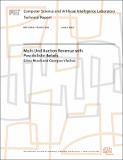Browsing CSAIL Technical Reports (July 1, 2003 - present) by Title
Now showing items 426-445 of 775
-
Mobilized ad-hoc networks: A reinforcement learning approach
(2003-12-04)Research in mobile ad-hoc networks has focused on situations in whichnodes have no control over their movements. We investigate animportant but overlooked domain in which nodes do have controlover their movements. ... -
Modeling Computational Security in Long-Lived Systems, Version 2
(2008-11-22)For many cryptographic protocols, security relies on the assumption that adversarial entities have limited computational power. This type of security degrades progressively over the lifetime of a protocol. However, some ... -
Modeling Network User Behavior: Various Approaches
(2016-06-28)This project involves learning to predict users' mobility within the network topology. Topological mobility, as opposed to physical mobility, can be substantial as a user switches from LTE to wifi network, while moving ... -
Modeling Radio Networks
(2009-06-04)We describe a modeling framework and collection of foundational composition results for the study of probabilistic distributed algorithms in synchronous radio networks. Existing results in this setting rely on informal ... -
Modular Generation and Customization
(2008-10-10)Modularity and flexibility can conflict in multi-language systems. For example, the templates commonly used to generate web pages must be manually updated when the database schema changes. Modularity can be improved by ... -
Moebius Language Reference, Version 1.2
(2014-04-09)Moebius is a representation and interface language based on a subset of English. It is designed for use as a means of encoding information and as a means of conveying information between software components and other ... -
Monitoring the Execution of Temporal Plans for Robotic Systems
(2012-10-04)To achieve robustness in dynamic and uncertain environments, robotic systems must monitor the progress of their plans during execution. This thesis develops a plan executive called Pike that is capable of executing and ... -
MOOS-IvP Autonomy Tools Users Manual
(2008-11-11)This document describes seven common MOOS-IvP autonomy tools. The uHelmScope application provides a run-time scoping window into the state of an active IvP Helm executing its mission. The pMarineViewer application is a ... -
MOOS-IvP Autonomy Tools Users Manual
(2010-08-23)This document describes fifteen MOOS-IvP autonomy tools. uHelmScope provides a run-time scoping window into the state of an active IvP Helm executing its mission. pMarineViewer is a geo-based GUI tool for rendering marine ... -
MOOS-IvP Autonomy Tools Users Manual Release 4.2.1
(2011-07-28)This document describes 19 MOOS-IvP autonomy tools. uHelmScope provides a run-time scoping window into the state of an active IvP Helm executing its mission. pMarineViewer is a geo-based GUI tool for rendering marine ... -
MORE: A Network Coding Approach to Opportunistic Routing
(2006-06-30)Opportunistic routing has the potential to substantially increase wireless network throughput. Prior work on opportunistic routing, however, requires tight node coordination. Different nodes in a network must have knowledge ... -
Motion Compatibility for Indoor Localization
(2014-08-26)Indoor localization -- a device's ability to determine its location within an extended indoor environment -- is a fundamental enabling capability for mobile context-aware applications. Many proposed applications assume ... -
Motion Coordination Using Virtual Nodes
(2005-04-06)We describe how a virtual node abstraction layer can be used to coordinate the motion of real mobile nodes in a region of 2-space. In particular, we consider how nodes in a mobile ad hoc network can arrange themselves along ... -
Mouse Behavior Recognition with The Wisdom of Crowd
(2013-09-19)In this thesis, we designed and implemented a crowdsourcing system to annotatemouse behaviors in videos; this involves the development of a novel clip-based video labeling tools, that is more efficient than traditional ... -
MPEG-2 in a Stream Programming Language
(2005-10-22)Image and video codecs are prevalent in multimedia applications, ranging from embedded systems, to desktop computers, to high-end servers such as HDTV editing consoles. It is not uncommon however that developers create ... -
Multi-Class Learning: Simplex Coding And Relaxation Error
(2011-09-27)We study multi-category classification in the framework of computational learning theory. We show how a relaxation approach, which is commonly used in binary classification, can be generalized to the multi-class setting. ... -
Multi-Output Learning via Spectral Filtering
(2011-01-24)In this paper we study a class of regularized kernel methods for vector-valued learning which are based on filtering the spectrum of the kernel matrix. The considered methods include Tikhonov regularization as a special ... -
Multi-Person Motion Tracking via RF Body Reflections
(2014-04-26)Recently, we have witnessed the emergence of technologies that can localize a user and track her gestures based purely on radio reflections off the person's body. These technologies work even if the user is behind a wall ... -
A Multi-Scale Generalization of the HoG and HMAX Image Descriptors for Object Detection
(2008-04-09)Recently, several powerful image features have been proposed whichcan be described as spatial histograms of oriented energy. Forinstance, the HoG, HMAX C1, SIFT, and Shape Context feature allrepresent an input image using ... -
Multi-Unit Auction Revenue with Possibilistic Beliefs
(2017-06-05)The revenue of traditional auction mechanisms is benchmarked solely against the players' own valuations, despite the fact that they may also have valuable beliefs about each other's valuations. Not much is known about ...



















